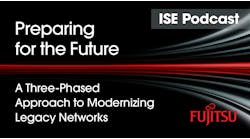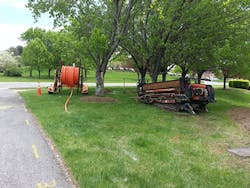Latest from Public Private Partnerships (P3)/Municipal Broadband
Municipalities Need a Local Transport Provider (LTP)
The Economics of Local Transport Services over Open Access Networks
The current business model for selling broadband in the US is an anachronism that evolved in the early 1990s with the introduction of dial-up Internet access. At that time, there was little more than email and a few text-based Web pages available on the Internet, so selling bandwidth "by the bucket" worked fine. For $20/month, subscribers got a "bucket of bandwidth" that was defined by some upper rate limit on that bandwidth — think of 14,400 bits/second or 56,000 bits/second. The by-the-bucket business model is simple: if users empty the bucket, the service provider refills it — and keeps refilling it every time it empties.
As the Internet evolved to include wide use of video and audio, and as new services like streaming video and 24/7/365 HD video streaming doorbells have become more common, more bandwidth is needed to support these uses. Broadband was and still is sold by the "bucket," but the bucket is now larger, with the DSL and broadband wireless buckets typically advertising a few megabits of bandwidth. While cable modem service typically advertises the size of their bucket "up to…" some imaginary number higher than 25 Meg down and 3 Meg up.
Cellular providers love the bandwidth by-the-bucket model, because as soon as the bucket is empty, they start charging outrageous fees to refill the bucket, even though it actually costs them almost nothing to do so.
Horizontal boring of fiber conduit.
Selling bandwidth by the bucket is weirdly contradictory — service providers make the least amount of money if customers like the service and use a lot of it — because of how often they have to refill the bucket. This approach is upside down from most other businesses, and it leads to odd behavior by the service providers that causes them to punish or even disconnect customers that like their service (i.e. use a lot of bandwidth).
For historical reasons, we have several fully duplicated networks delivering broadband in the US. We have a very old copper twisted-pair network used to deliver broadband via DSL, and we have a somewhat newer coaxial copper network delivering broadband via cable modem. And for mobility access across the US, we have 4 cellular voice/data networks. How many times have you seen 2, 3, or even 4 cell towers within view of each other? And we have Wireless Internet Service Providers (WISPs) and FTTx providers building more modern, but still private, closed networks.
The development of high-performance fiber and wireless network technology and the concurrent development of the Internet (TCP/IP) protocols made building a separate network for each service or provider unnecessary. A modern fiber or wireless network can easily transport the services offered by many different providers; buyers can pick and choose the services they want based on the cost and quality of each service.
Duplicating networks only raises costs for customers. From the provider perspective, by owning the network end-to-end, they also own the customer. Deregulation in the 1980s and 1990s was supposed to introduce competition, drive down prices, and give customers more choice of providers. Instead, we got the Balkanization of American telecom.
Installing conduit for a middle mile fiber route.
Prior to 1984, we had a single large monopoly controlling telecom in America (i.e., AT&T and the Baby Bells). No choice, no competition.
Today, we have many thousands on mini and micro monopolies throughout the US, where providers have simply sliced up the markets. The on-the-ground reality for many broadband users, both residential and business, is a continued lack of service alternatives and ever-increasing prices.
The Open-Access Model
The open-access business model changes everything by creating a single, high-performance network shared both by all on-network providers and among all public and private users. It is, essentially, a high-performance digital road system. Just as a single unified road system is shared by all the cars and trucks using the road, an open access network shares transport in the same way.
Open-access networks unbundle transport of the services from the services themselves. The network owner is not a service provider. Instead, the network owner function needs a new term: the local transport provider, or LTP.
The open-access business model has 4 components:
1. The combination of passive network infrastructure and network electronics delivers services from service providers to customers.
2. The LTP manages the network infrastructure and ensures that each service provider has adequate bandwidth and network quality of service (QoS) to deliver each service consistently to each customer.
3. Service providers contract to use the network infrastructure to sell a variety of services at various price points to their own customers.
4. Customers buy the service or services of their choice from one or more service providers that use the network infrastructure.
When an LTP provisions and manages a modern broadband network, service providers can focus on delivering higher-quality services and more kinds of services at lower cost because the network transport costs are now shared among many providers and services rather than absorbed completely by 1 provider with 2 or 3 non-competitive services.
In large parts of the US, incumbents have made it clear that they cannot make a business case for replacing their copper-based network infrastructure. That is probably true, because their business case requires continued investment in a private end-to-end network that carries only a few of their own services.
A shared network, owned by a local transport provider and made available to all incumbent providers as well as to any other competitive provider, brings the provider capital expense to reach the next customer down to nearly zero.
It is unfortunate that open access has become associated with a local government competing directly with private sector providers at the retail services level. Nothing about the open-access business model requires government involvement or government ownership of the network. Some private networks can and do operate on an open-access model.
A key advantage of open access is that it has network neutrality baked in, as buyers of services can pick and choose from a wide variety of service providers and services rather than being chained to the offerings of a single, de facto monopoly provider. No regulation is needed because the model creates a competitive marketplace inherently.
The availability of an LTP-managed network also enables new business and service opportunities for nontraditional providers. When the network is unbundled from services and service providers, smaller local and regional providers can compete very effectively against the larger incumbent providers.
A local transport network can support services and applications that formerly may have been too costly. For example, a local government could use the open-access network to control traffic signals, manage energy-saving street lights, support a security camera system in high crime areas, have real-time monitoring of pump stations, and collect data from other government facilities. In the past, expensive leased lines from the incumbent carrier made these kinds of Smart City applications prohibitively expensive.
In summary, the open-access business model is straightforward: a network owner (the LTP) provides local transport to several independent, private-sector service providers. Each provider offers multiple competitively priced services to its own customers. Network revenue is derived from fees collected for transporting service provider traffic locally across the network to retail customers. Open access can deliver what end users want: choice of providers, choice of services, competitive pricing, and high performance.






